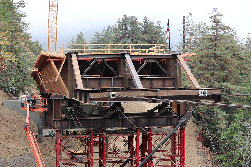A February 2017 landslide under the 1968 Pfeiffer Canyon Bridge fractured a bridge column. Photo by District 5 
By Susana Z. Cruz
District 5 Public Information Officer
The second wettest winter on record cut access to the world-famous Big Sur California coastline with two historic landslides on State Route 1 – one that is still blocking access at Mud Creek to the south, and one that fractured a column and forced the closure of the iconic Pfeiffer Canyon Bridge, built in 1968 to connect Big Sur to Carmel in the north.
Although less than 1,000 people live within the 76-mile coastal stretch, tourists from all over the world visit the area known as the longest and most scenic stretch of undeveloped coastline in the contiguous United States. The area has a history of slides, and this summer Big Sur was isolated from vehicular traffic on both sides.
On Feb. 15, Caltrans and the California Highway Patrol helped locals and tourists cross the canyon and the Department permanently closed the old Pfeiffer Canyon Bridge.
“We knew from the very beginning that demolition of the bridge, followed immediately by its reconstruction, would be a major undertaking with some elements that had never been done before in California,” said Caltrans Structures Engineer David Galarza.
The bridge demolition began in mid-March. It was a very slow, methodical and precise operation that took nine days and was completed by using a 6-ton wrecking ball and hoe ram to break the bridge into smaller pieces. The 315-foot long concrete bridge with its three spans was brought down over six days in mid-March.
Caltrans District 5 employees have a strong, close-knit relationship with the Big Sur community. Realizing a main automobile artery was cut between north and south Big Sur, straining local access and business, an expedited bridge design was developed in only three weeks instead of several months. Steel was the element chosen versus concrete. It rendered speedier fabrication and was ordered even before final design for the new bridge was complete.
The steel parts were made all over the U.S. and shipped to the XKT Plant in at Mare Island in Vallejo for girder fabrication. There, the 62-ton, 62-foot-long steel girders were fabricated by assembling, welding and drilling each girder to produce 15 of them, all in six weeks. The fabricating plant was less than a mile from the Caltrans Materials Department, which allowed for convenient coordination.

Caltrans used tension cables to pull the pieces of the bridge across the rugged Pfeiffer Canyon.
Photo by District 5
The girders were then shipped to a factory near Stockton for painting, while bridge work at Pfeiffer Canyon took place concurrently. Abutment construction began in April and was completed in July. After painting, the girders were delivered, escorted three at a time, to be off-loaded one at a time at Pfeiffer Canyon. This was preparation for the girder assembly consisting of three girders and cross members bolted in between each girder, totaling 15. This was in preparation for the launching, which took about two weeks.
Caltrans used tension cables to pull the assembled girders 18 inches at a time, after which each pull was thoroughly checked. Nine hundred tons of steel were pulled more than 300 feet over the canyon, guided by a temporary support column, a feat never before done in California.
Before Caltrans could say the bridge was fully installed, it needed to be lowered into place by using special jacks that were programmed to ‘lower’, instead of the typical ‘raising’ motion done by hydraulic jacks. During most of the accelerated bridge construction, the contractor and Caltrans employees worked seven days a week.
It took about two weeks to lower the bridge. The bridge deck followed. Concrete was used in the diaphragms and deck, traditional in concrete bridges. This was a quick process that only took a few days.
From start to finish, the new Pfeiffer Canyon Bridge only took seven months to complete—a process that normally takes seven years. Caltrans employees and contractors put forth heroic efforts to deliver according to schedule, sacrificing family time and weekends—all the while, acutely aware of the Big Sur community and their need to regain some normalcy.
“The Big Sur community and travelers around the world can thank Caltrans for its immediate response to rebuild this bridge, allowing the public to visit this remarkable part of California and enjoy the many attractions along this corridor,” said Kirk Gafill of the Big Sur Chamber of Commerce.
According to Caltrans project manager David Silberberger, a key element for the success of this project was the seamless partnership between Caltrans and the contractor, Golden State Bridge—because of that, the work was finished quickly and safely, delivering a structure that is ready to serve travelers for the next 75 years.

